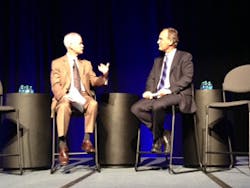DETROIT —Transportation is changing significantly; it is impacting collision repair; and anticipating and responding to change is essential.
Lawrence D. Burns, PhD, Professor of Engineering Practice, University of Michigan and former vice president, R&D and Planning with General Motors (1998-2009), discussed “The Changing DNA of the Vehicle” at the I-CAR Conference in Detroit, July 30.
Serious challenges face the transportation industry: safety; energy consumption; congestion; parking, environmental concerns; and infrastructure.
These challenges beg the question, “Is the automobile transportation system truly sustainable? I don’t think it is. The good news is there is a new DNA emerging, one that is driven by electrical drive and electric motors, diverse energy sources, connected and coordinated technologies and driverless developments,” Burns says.
Vehicles can fight challenges by combining five elements — connected, coordinated, shared, tailored and driverless systems.
Connected vehicles communicate with other vehicles on the road through transponders and GPS systems, among others. Coordinated vehicles take all this information — where people are, where they want to go — and coordinate this information so the industry can best match supply and demand. Shared vehicles may be a better system for automobile use. “When we buy and own our car, we think it is a rational decision,” Burns says. “But it sits idle 90 percent of the time. And parking is a negative impact on the vehicle ownership experience. So more and more companies are coming out with vehicle sharing capabilities.”
Tailoring is a system design opportunity. For example, most automobile trips are one to two-person trips, yet drivers often have four to six passenger vehicles, Burns says. And most trips have an average speed of 25 miles per hour, but vehicles are designed to go much faster.
Driverless systems “are not a fairy tale,” he says. Google is on record to have its self-driving vehicle ready to sell by 2017. “The biggest risk [in driverless technology] is not moving fast enough.”
“All these options give us an opportunity to have a better mobility experience and significantly lower societal costs,” Burns says.
These technologies will drive lower demand for the collision repair industry, Burns says. “There will be fewer crashes and these crashes will be less severe. They will be more complex, with more technology, more materials, more fastening systems and more vehicle types,” he says. “Vehicle repairs will require more know how, more equipment and more information systems. And there will be higher expectations — you will see more demanding vehicle owners and business partners. These new technologies will also further drive industry consolidation.”
To be prepared, the industry has to take action, he says.
“You have to get in front of the inevitable and comprehend what is possible. You have to think big, start small and learn fast. You have to develop the know how to respond to opportunities,” Burns says. “You have to make purposeful decisions.”


